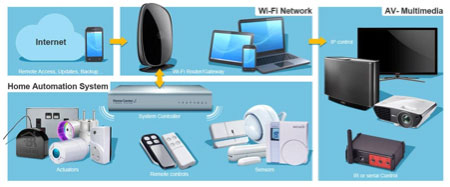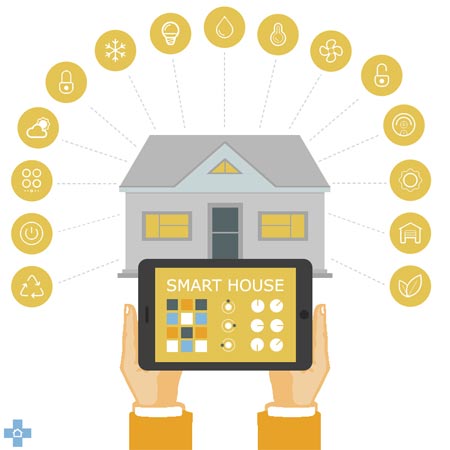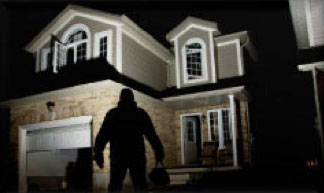Home automation is a modern innovation driven by the rise of the internet. It allows you to control electronic devices in your home via an app.
To learn more about this exciting technology, continue reading below.
Why Do You Want a Smart Home?
Transforming your home into a smart home may not seem like a top DIY priority, but the benefits are significant. From enhancing your quality of life to boosting security and saving money, smart home technology offers numerous advantages.
The primary benefit is remote control. Smart home tech allows you to adjust the settings of internet-connected devices even when you’re not home. For instance, if you set your heating to turn on at a certain time but your plans change, you can easily modify the schedule via an app, preventing unnecessary heating and saving money.
Additionally, if your lights and curtains/blinds are automated, you can adjust them remotely to make it appear someone is home, deterring potential burglars.
This is just the beginning. If you’re new to Smart Homes and Home Automation, read on to discover the latest DIY trend that’s rapidly gaining popularity.
What is Home Automation?
Home automation connects devices in your home for easy and efficient control. Here’s how Wikipedia defines it:
Home automation or smart home (also known as domotics or domotica) is the residential extension of building automation and involves the control and automation of lighting, heating (such as smart thermostats), ventilation, air conditioning (HVAC), and security, as well as home appliances such as washer/dryers, ovens, or refrigerators/freezers that use WiFi for remote monitoring. Source: Wikipedia
While this definition sounds complex, home automation can be very simple. It allows you to control devices remotely, directly, or with sensors and timers, so they operate only when needed. For instance, you can switch on lights remotely.
In essence, home automation enables remote and automatic control of household items. Even your old TV with a remote control is a basic form of home automation!
So, why the buzz around Smart Homes, Home Automation, and the Internet of Things? These concepts are interrelated. Thanks to affordable wireless technologies, smart homes are now cheaper and easier to retrofit without extensive cabling. Designing and installing a smart home system is an ideal DIY project, even if it expands the traditional scope of DIY!
How Does a Smart Home System Work?
Understanding how a home automation system works will help you realise its potential and why you might consider creating your own smart home. Let’s break it down before diving into what these systems can do.
Experts often say a smart home system “can be anything you want it to be”. While true, this can be overwhelming without understanding the basics. So, we’ll start with the ”how” and then explore the ”what it can do“ to make it clearer.

The Key Components of a Home Automation System (image: Vesternet.com)
Every smart home system consists of some or all of the devices shown above. The number and type of components depend on your goals and how advanced you want to get. Here are the key components you’ll need:
Actuators
Actuators are the devices your smart home system controls, such as lights, heating, or appliances. Here are the most common types:
- Switches: Also known as relays, these turn lights or appliances on and off.
- Wall Plugs: Inserted into wall sockets, they control the power to any plugged-in device and can monitor energy usage.
- Dimmers: Switches that also adjust brightness levels.
- Wall Sockets: Replacing standard sockets, these are controlled wirelessly (currently available through LightwaveRF).
- Door Locks: Allow you to control access to your home remotely.
- Alarms or Sirens: Emit sounds triggered by the home automation system.
- Boiler Receivers: Wired into your boiler, enabling remote control via the home automation system, often used with wireless thermostats.
- Thermostatic Radiator Valves (TRVs): Control individual radiators based on room temperature.
- Cameras: Allow for remote viewing and recording of activity in and around your home.
Sensors
Sensors detect and monitor conditions, sending data to your home automation system to trigger actions or provide alerts. Here are common types:
- Motion Sensors: Detect movement using PIR technology to trigger alerts.
- Door or Window Sensors: Monitor the opening and closing of doors and windows.
- Smoke Sensors: Trigger alerts when smoke or excessive heat is detected.
- Flood Sensors: Detect the presence of water to alert you to leaks or flooding.
- Temperature Sensors: Monitor temperature changes to trigger actions or alerts when thresholds are met.
- Energy Monitors: Measure the energy consumption of individual appliances or the entire home.
Remote Controllers
Remote controllers let you manage your smart home system. They can also be used alongside the Control Unit, smartphone, or tablet. Here are common types:
- Handheld: Similar to a TV remote, for easy control.
- Wireless Wall Switch: Wall-mounted for convenient access.
- Key-Fob: Compact remotes designed for your key ring.
System Controller
The System Controller, also known as the Hub or Gateway, is the “brain” of your smart home. It processes inputs from sensors and activates actuators, automating your devices based on your preferences.
Connections for the System Controller include:
- Wireless: Communicates with sensors and actuators using dedicated wireless technology, similar to home Wi-Fi but for home automation.
- Internet: Connects to the internet via your Wi-Fi router using an Ethernet cable, enabling remote access, updates, backups, and time synchronisation.
These components form the core of any smart home system. You can expand by adding more devices to automate tasks, enhance safety, and improve efficiency or cost-effectiveness.
Many users also connect their AV (Audio Visual) and multimedia systems to their home automation. For example, TVs and stereo systems usually need a different connection method:
- IR (InfraRed): Most AV equipment uses IR, like your TV remote. You can integrate these with an adapter (e.g., ITach IR adapter) that allows the System Controller to send commands to the IR device.
- IP Controlled Equipment: Modern devices, such as Smart TVs and Sonos, can connect to the internet via Wi-Fi or Ethernet. Since the System Controller is connected to your Wi-Fi network, it can communicate with these devices.
Smart Home Technology/Protocol Choices
Smart home technologies use low-power radio frequencies to communicate. Here are some common options, each with its own pros and cons:
- Z-Wave: A mesh network where devices repeat signals to avoid black spots. Z-Wave Plus is the latest version, compatible with older devices. Learn more about Z-Wave.
- LightwaveRF: An affordable option ideal for lighting and power control, especially popular in the UK. Discover LightwaveRF.
- X10: One of the oldest technologies, invented in 1975. It’s inexpensive but outdated compared to newer options.
- Zigbee: An open-source protocol supported by many global electronics manufacturers. Find out more about Zigbee.
- EnOcean: A German open-source protocol that uses low energy, allowing sensors to “harvest” energy from temperature and light changes. Learn more about EnOcean.
- Insteon: A dual-band network using both wireless and power lines for increased reliability. It also operates as a mesh network.
- Bluetooth Smart: Also known as Bluetooth Low Energy (BLE), it’s energy-efficient and reliable, suitable for home automation. Most homes already have Bluetooth-enabled devices.
- Wi-Fi and Ethernet: Many smart home devices now use Wi-Fi for easy integration. Ethernet offers a wired connection for robust signal strength.
Some devices support multiple protocols for enhanced functionality and compatibility. Always check compatibility between systems and devices before purchasing. Regardless of the technology you choose, your smart home system will consist of a System Controller, Sensors, and Actuators.
What is Home Automation and What Can a Smart Home Do?
Home automation allows you to control devices in your home remotely, keeping you informed and in control of your environment.

The capabilities of home automation systems
The possibilities are extensive. Start with the essentials and expand as you become more comfortable with the technology. As you gain confidence, you can make adjustments from anywhere via the internet.
Many of us have already used early home automation devices, such as PIR security lights, remote key fobs for garage doors, and wireless heating controls. Now, these devices can be integrated into a single system that you can manage remotely.
Here are some common starting points for a home automation system:
Security
Home security is a major concern, especially when you’re not there. Traditional alarm contracts can be costly, and it’s hard to remember if all doors and windows are secured. Home automation offers practical security solutions:
- Check if your home is secure with the touch of a button, seeing which windows or doors are open.
- Remotely lock or unlock doors to grant access or ensure security, even from miles away.
- Use cameras to monitor your home, distinguishing between a pet or an intruder, and take action if necessary, even while on vacation.
Thanks to recent technological advances and reduced costs, companies like SimpliSafe and Verisure offer affordable, wireless security systems you can control and monitor online for just a few hundred pounds.
Unlike older systems requiring complex setups, these new solutions are user-friendly and can be installed in minutes, even by beginners.

Use Home Automation to secure your home
Lighting Controls
Smart lighting is one of the easiest and most popular home automation features. It’s simple to set up and greatly enhances convenience. Here are some ways to automate your lighting:
- Automate lights to turn on/off when someone enters or leaves a room, saving energy and preventing fumbling in the dark.
- Adjust brightness and colour to match your mood. You can even control blinds for optimal lighting.
- Schedule lights to be on when you return home and make adjustments remotely via the internet.
Thanks to technological advances, automating your lighting is now straightforward with various options available. Systems like Philips Hue allow colour adjustments via Bluetooth, while Google Home and Amazon Alexa offer more comprehensive control.

Automate the lighting in your home
Heating Control
Efficiently managing your heating can save you significant money, and home automation excels in this area. Here’s how:
- Remotely adjust heating to reduce energy consumption by heating only when and where necessary.
- Monitor heating usage to prevent surprises and identify areas where energy is being wasted.
- Enhance comfort by maintaining your home at the desired temperature only when needed.
Heating control is widely recognised in home automation, with systems like Google Nest allowing full control of boilers and heating via an app from anywhere. Recent advancements have also made these systems more affordable and accessible to all.
Smart Speakers and Voice Services
The evolution of smart speakers and voice assistants by tech giants like Google, Apple, and Amazon has revolutionised home automation.
Voice assistants such as Siri, Alexa, and Google Assistant have propelled smart speaker technology to unprecedented levels. They seamlessly integrate with various automation systems, allowing you to control everything from adjusting the thermostat to ordering groceries with a simple voice command.
These assistants are ubiquitous, capable of interacting with nearly every smart device on the market. Whether you’re asking about the weather or controlling home appliances, voice commands make it effortless.
Furthermore, thanks to rapid advancements, basic smart speakers like the Amazon Alexa Echo are now incredibly affordable, often priced under £50.
Smart speakers and voice services are not only transforming homes but are also expanding into cars, buildings, and even kitchen appliances. This area continues to lead the charge in home automation innovation.
With the advent of wireless technologies like Z-Wave and LightwaveRF, coupled with widespread voice assistants, setting up a Smart Home system is now affordable and accessible to everyone. Home automation has evolved into a DIY endeavor, eliminating the need for specialized skills.

